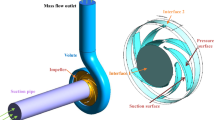Abstract
Flow instability in LRE (liquid rocket engine) occurs due to various reasons such as flow interactions with valve, orifice and venturi, etc. The inception of cavitation, especially in the propellant feeding system, is the primary cause of mass and pressure oscillations because of the cyclic formation and depletion of cavitation. Meanwhile, the main propellant in a liquid rocket engine is the cryogenic fluid, which properties are very sensitive to temperature variation. And the change of propellant properties to temperature variation by thermodynamic effect needs to be properly taken into account in the flow analysis in order to understand basic mechanisms for cryogenic cavitation. The present study focuses on the formation of cryogenic cavitation by using the IDM model suggested by Shyy and coworkers. The flow instability was also numerically investigated in the downstream of orifice with a developed numerical code. Calculation results show that cryogenic cavitation can be a primary source of flow instability, leading to mass fluctuations accompanied by pressure oscillations. The prediction of cavitation in cryogenic fluid is of vital importance in designing a feeding system of an LRE.
Similar content being viewed by others
References
W. K., Cho and Y. S., Jung, Analysis of flow rate control of cavitating venturi, The KFMA Annual Meeting, Pukyong National University(Youngdang Campus), (2000) 318–324.
Tokumasa, Y. Sekino and K. Kamijo, A new modeling of sheet cavitation considering the thermodynamic effects, 5th International Symposium on Cavitation, Osaka, Japan, November 1–4, (2003).
Y. Utturkar, J. Wu, G. Wang and W. Shyy, Recent progress in modeling of cryogenic cavitation for liquid rocket propulsion, Aerospace Sciences, vol.41. (2005) 558–608.
A. K. Singhal, M. M. Athavale, H. Li and Y. Jiang, Mathematical basis and validation of the full cavitation model, in ECCOMAS, European Congress on Computational Methods in Applied Science and Engineering, (2004).
C. L. Merkle, J. Feng and P.E.O. Buelow, Computational modeling of dynamics of sheet cavitation, Proceedings of the 3rd international symposium on cavitation, Grenoble, France, (1998).
R. F. Kunz, D. A. Boger, D. R. Stinebring, T. S. Chyczewski and H. J. Gibeling, A preconditioned Navier-Stokes method for two-phase flows with application to cavitation prediction, AIAA-99-3329, (1999).
S. Lee, C. Lee and S. Park, Numerical simulation of unsteady cavitating flow around 2D hydrofoil, KSME Journal, Vol 31, No 8. (2007) 653–662
C. L. Yaws, Chemical Properties Handbook, Mc-Graw-Hill, (1999).
M. Oike, T. Tokumasu1 and K. Kamijo, Observation of helium two-phase flow in a pipe, CAV2001, (2001).
V. Ahuja, A. Hosangadi and P.A. Cavallo, Analyses of transient events in complex valve and feed systems, 41st AIAA/ASME/SAE/ASEE Joint Propulsion Conference & Exhibit, Tucson, (2005).
Author information
Authors and Affiliations
Corresponding author
Additional information
This paper was recommended for publication in revised form by Associate Editor Jun Sang Park
Changjin Lee received his B.S. and M.S. degrees in Aeronautical Engineering from Seoul National University in 1983 and 1985. He then went on to receive his Ph.D. degree from University of Illinois at Urbana- Champaign in 1992. Dr. Lee is currently a Professor at the department of Aerospace Engineering at Konkuk University in SEOUL, Korea. His research interests are in the area of combustion instabilities of hybrid, liquid rocket and jet propulsions.
Tae-Seong Roh received his B.S. and M.S. degrees in Aeronautical Engineering from Seoul National University in 1984 and 1986. He then went on to receive his Ph.D. degree from Pennsylvania State University in 1995. Dr. Roh is currently a Professor at the department of Aerospace Engineering at Inha University in Incheon, Korea. His research interests are in the area of combustion instabilities, rocket and jet propulsions, interior ballistics, and gas turbine engine defect diagnostics.
Rights and permissions
About this article
Cite this article
Lee, C., Roh, TS. Flow instability due to cryogenic cavitation in the downstream of orifice. J Mech Sci Technol 23, 643–649 (2009). https://doi.org/10.1007/s12206-008-1221-z
Received:
Revised:
Accepted:
Published:
Issue Date:
DOI: https://doi.org/10.1007/s12206-008-1221-z




